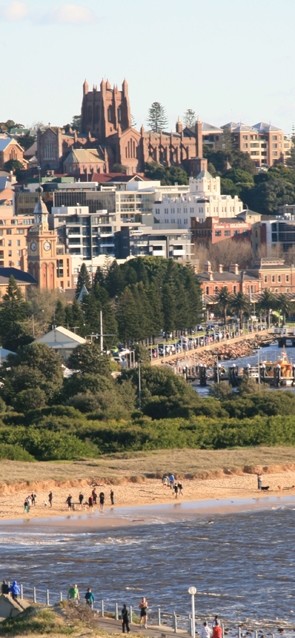New planning controls for Newcastle have been approved, revised maximum building heights among controls to guide the revitalisation of the city centre.
After community consultation, plans were revised to limit future buildings from exceeding the height of the parapet of the Christ Church Cathedral nave.
The updated Local Environment Plan (LEP) and Development Control Plan (DCP) was approved last week.
 Plans were exhibited in March with 266 submissions received, largely around the proposed height of three towers on the GPT / Urban Growth site in the East End.
Plans were exhibited in March with 266 submissions received, largely around the proposed height of three towers on the GPT / Urban Growth site in the East End.
As a result of the submissions, the maximum building height on the GPT/Urban Growth site has been reduced by 10.6 metres from 69.5 metres (approximately 20 storeys) to 58.9 metres (approximately 17 storeys) to ensure buildings do not exceed the height of the parapet of the Christ Church Cathedral’s nave.
Architecture & Design recently reported plans for what would be the city’s tallest building, a 57-metre tower designed by Snell Architects.
The consultation earlier this year was in addition to feedback received during the initial community consultation period which concluded in 2013 and attracted 420 submissions.
Changes to the earlier draft LEP included allowing more floor space and higher buildings on some sites, following submissions from the University of Newcastle and UrbanGrowth NSW.
The department says the community will be consulted further on possible future uses for the disused rail corridor land.
NSW Minister for Planning Pru Goward said the measures in place will protect the unique character of the city.
“We always said these plans should and would be informed by the community, that’s why the Department of Planning & Environment has moved to reduce the maximum building height to ensure the heritage integrity of the Newcastle skyline,” she said.
“These planning controls will help shape the city centre to take advantage of the significant investment in new public transport being made by the NSW Government in partnership with council and the community.”
-
The new planning controls and update to the Newcastle Urban Renewal Strategy were also released. Key points:
-
Maintain the city’s historic skyline with Christ Church Cathedral set to remain the highest building
-
Re-establish Hunter Street as the City’s main street, revitalising the mall and the East End
-
Promote jobs growth by allowing for a University of Newcastle presence in the CBD, including a previously announced $25 million contribution from the NSW Government
-
Attract retail back to the city centre, creating jobs and encouraging shopper activity
-
Take advantage of the NSW Government’s investment in light rail and other public transport improvements and the renewal of Newcastle
-
Deliver new connections between the city centre and the waterfront.
Recently released population projections show that Newcastle’s population will hit 190,000 by 2031 – a 22 per cent increase.
“This is creating exciting opportunities for NSW’s second city, but we need to ensure those new Novocastrians have a home, a job and an efficient way to get between the two,” Goward said.
“These plans allow capacity for an additional 10,000 jobs and 6,000 homes to be created in the city centre by 2036 – homes and jobs that will be supported by new and renewed transport infrastructure.
“After working closely with the Member for Newcastle Tim Owen who fought hard to ensure the community’s voice was heard, we now have planning controls that provide the framework for the delivery of a long-term vision for the future – planning for a growing Newcastle.”
Member for Newcastle Tim Owen said he was pleased the Department had heeded community’s concerns about the maximum building height in the East End.
“It is possible to protect the things we value while providing the housing and jobs we will need into the future, and that’s what I’m very pleased to have seen happen here,” Owen said.
Lord Mayor of Newcastle Jeff McLoy said the new planning controls recognised the city’s bright future.
“As the capital of the Hunter and the second largest city in NSW, Newcastle needs a strong plan to guide and shape our growth,” McLoy said.
“I want to make sure that our city is prepared for the future and a modern set of planning controls for the city’s centre is an important first step in helping the city realise its full potential.
“I’m proud that the community has embraced the opportunity for change and has been involved every step of the way in planning for a growing Newcastle.”
Image source: newcastlecathedral.org.au

